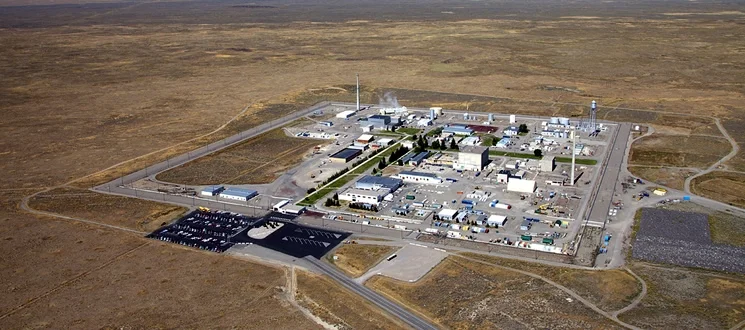IDAHO
Photo courtesy of Energy.gov
DASHBOARD
-
The Idaho National Laboratory (INL), an 890-square-mile section of desert in Eastern Idaho, was established in 1949 as the National Reactor Testing Station. Initially, the missions at the INL were the development of civilian and defense nuclear reactor technologies and management of spent nuclear fuel. Fifty-two reactors—most of them first-of-a-kind—were built, including the Navy’s first prototype nuclear propulsion plant. Of the 52 reactors, three remain in operation at the site. In 1951, the INL achieved one of the most significant scientific accomplishments of the century—the first use of nuclear fission to produce a usable quantity of electricity at the Experimental Breeder Reactor No. 1 (EBR-1). The EBR-1 is now a Registered National Historic Landmark open to the public.
During the 1970s, the name of the site was changed from the National Reactor Testing Station to the Idaho National Engineering Laboratory. This change reflected the broadened mission into biotechnology, energy and materials research, and conservation and renewable energy. The name changed again in 1997 to the Idaho National Engineering and Environmental Laboratory. This change reflected a major refocus toward engineering applications and environmental solutions. On February 1, 2005, the name changed again to the Idaho National Laboratory (INL). This change reflects a move back to the laboratory’s historic roots in nuclear energy and national security.
View a “Virtual Field Trip” of Idaho National Laboratory produced by Discovery Education and the American Nuclear Society.
-
-
Shoshone-Bannock Tribes
-
The Idaho Cleanup Project Citizens Advisory Board is a federally appointed citizens' panel that provides independent advice and recommendations to the Office of Assistant Secretary, and designees, for the U.S. Department of Energy's (DOE) Environmental Management (EM) Program.
-
Battelle Energy Alliance (BEA) – INL Management & Operations
BEA is made up of Battelle, BWX Technologies, Inc., Amentum, Electric Power Research Institute (EPRI), and University Partners
Idaho Environmental Coalition, LLC (IEC)
In 2021, the Idaho Environmental Coalition, LLC (IEC) was selected by the U.S. Department of Energy (DOE) to manage cleanup operations at the Idaho National Laboratory (INL) Site under a ten-year, $6.4 billion contract. IEC is led by Jacobs and includes North Wind Portage as a partner.
-
Federal Government
State Government
Local Government
-
Idaho National Laboratory
Sarah Neumann
Phone: (208) 526-0490; Email: Sarah.Robertson@inl.gov
Idaho Cleanup Project Citizens Advisory Board
Jordan Davies, Project Staff
Phone: (208) 557-7886; Email: Jordan.Davies@em.doe.gov
City of Idaho Falls
Eric Grossarth, Public Information Officer
Phone: (208) 612-8562; Email: egrossarth@idahofalls.gov
Site Budget
| FY 2024 Enacted | FY 2025 Request | FY 2025 House Bill |
|---|---|---|
| 478,205 | 459,243 | 492,011 |
(INL Defense Environmental Cleanup. Amounts in thousands of dollars. Click here for the latest site budget.)
Nicholas Balsmeier
Acting Manager, Idaho Cleanup Project
CLEANUP ISSUES
-
Special Nuclear Materials and Spent Nuclear Fuel
Transuranic and Solid Waste Disposition
Tank Waste
Soil and Groundwater Remediation
-
In March 2022, the Office of Environmental Management released a Strategic Vision for 2022-2032.
Planned Cleanup Scope 2022–2032
Over the coming decade, cleanup activities at the INL Site will focus on completing treatment of remaining liquid sodium-bearing waste, buried waste exhumation, shipment of remaining TRU waste, and decommissioning and closure of facilities at the RWMC and INTEC.
Nuclear Energy Projects
-
The U.S. Department of Energy (DOE) approved a multi-year cost share award to a new special purpose entity named Carbon Free Power Project, LLC, an entity wholly owned by Utah Associated Municipal Power Systems (UAMPS), that could provide up to $1.4 billion to help demonstrate and deploy a 12-module NuScale power plant located at Idaho National Laboratory. The agreement serves as a funding vehicle and is subject to future appropriations by Congress. Construction for UAMPS' Carbon Free Power Project is expected to begin in December 2025, with the first power module operating at the lab by 2029.
-
In February 2019, the U.S. Department of Energy (DOE) announced its plans to build a Versatile Test Reactor, or VTR. Once built, the research community will be able to leverage VTR’s high neutron flux to test nuclear materials 10 times faster than what is currently capable today.
VTR will:
Modernize DOE’s essential nuclear energy research and development infrastructure.
Accelerate the development of advanced nuclear fuels, materials, instrumentation, and sensors.
Reestablish the United States as a global leader in nuclear science and innovation.
Support the nation’s goal of reaching net-zero carbon emissions by 2050.
The VTR project is led by Idaho National Laboratory in partnership with five national laboratories (Argonne, Los Alamos, Oak Ridge, Pacific Northwest, and Savannah River) and includes a host of industry and university partners.
Updated August 2022.
Information in this profile is sourced from DOE, NNSA, and the site’s online resources.


